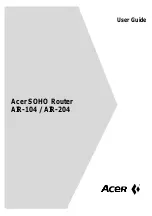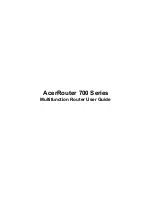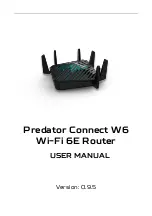
18
GUIDE
FEED
ROTATION
GUIDE INSIDE
THRUST
ROTATION
ROTATION
ROTATION
GUIDE OUTSIDE
FEED
GUIDE
THRUST
PROPER RATE OF FEED
Professional routing depends upon careful setup and proper
rate of feed which is learned through practice and use. The
proper rate of feed is dependent upon:
hardness and moisture content of the workpiece
depth of cut
cutting diameter of the bit
When cutting shallow grooves in soft woods such as pine, a
faster rate of feed can be used. When making cuts in hard-
woods such as oak, a slower rate of feed is required.
Several factors will help you select the proper rate of feed.
Choose the rate that does not slow down the motor.
�Choose the rate at which the bit advances firmly and
surely to produce a continuous spiral of uniform chips
or a smooth edge.
Listen to the sound of the motor. A high-pitched sound
means you are feeding too slowly. A strained, lower
pitched sound signals force feeding.
�Check the progress of each cut. Too slow feeding can
cause the router to take off in a wrong direction from the
intended line of cut. Force feeding increases the strain
of holding the tool and results in loss of speed.
OPERATION
DIRECTION OF FEED AND THRUST
See Figures 16 - 17.
The router motor and bit revolve in a clockwise direction. This
gives the tool a slight tendency to twist in a counterclockwise
direction, especially when the motor revs up.
Feed the router into the workpiece from left to right. When
fed from left to right, the rotation of the bit pulls the router
against the workpiece. If fed in the opposite direction, the
rotation of the spinning bit will tend to throw the router away
from the workpiece causing kickback. This could cause you
to lose control of the router.
Because of the high speed of bit rotation during a proper
feeding operation, there is very little kickback under normal
conditions. However, if the bit strikes a knot, hard grain,
or foreign object that affects the normal progress of the
cutting action, there will be a slight kickback. The direction
of kickback is always in the direction opposite bit rotation.
This will affect the trueness of the cut.
To guard against kickback, plan the setup and direction of
feed so that you will always be thrusting the tool in the same
direction that the leading edge of the bit is moving. The thrust
should be in a direction that keeps the sharp edges of the
bit continuously biting straight into new (uncut) wood.
NOTE:
For best results, make sure to take enough time to
set up for cutting. While cutting, make sure to use the proper
rate of feed.
Fig. 16
Fig. 17
PROPER
CUTTING
SEQUENCE
2
5
8
4
7
3
6
1
Notice the chips being produced as you cut. If the router
is fed too slowly, it will scorch or burn the wood. If fed
too fast, it will take large chips out of the wood and leave
gouge marks.
Test a cut on a scrap piece of the workpiece before you
begin. Always grasp and hold the router firmly with both
hands.
If you are making a small diameter, shallow groove in soft,
dry wood, the proper feed rate may be determined by the
speed at which you can travel the router along the guide line.
If the bit is a large one, the cut is deep, or the workpiece is
hard to cut, the proper feed may be a very slow one. A cross
grain cut may require a slower pace than an identical with
grain cut in the same workpiece.
1/4 in. to 1 in.







































